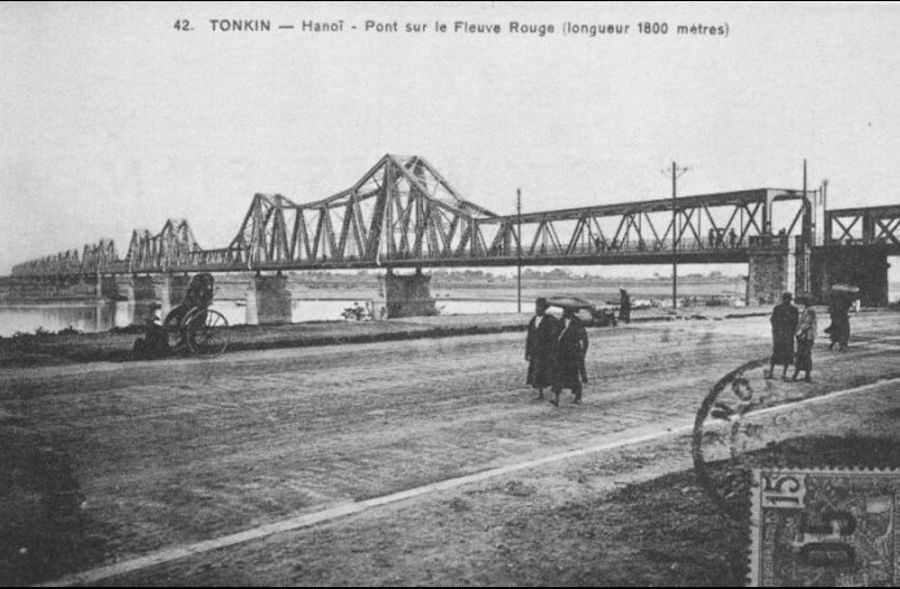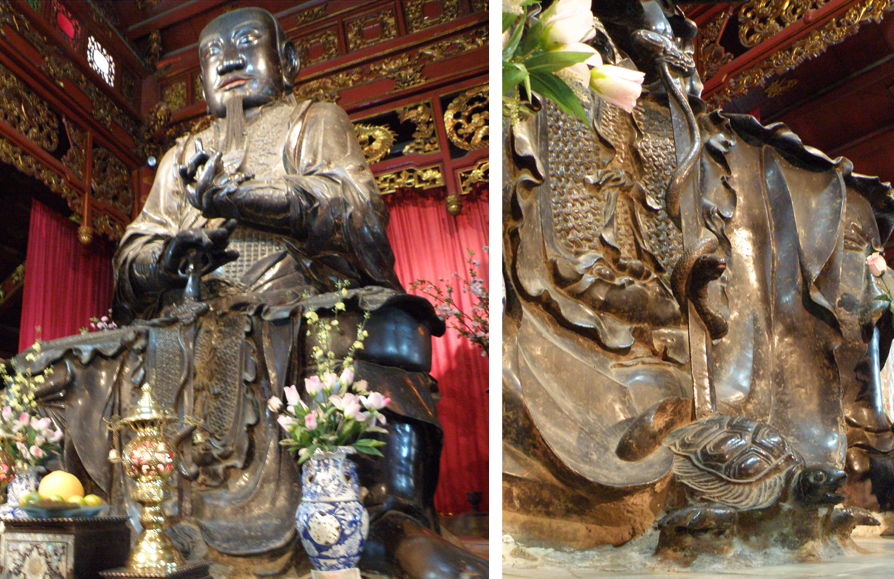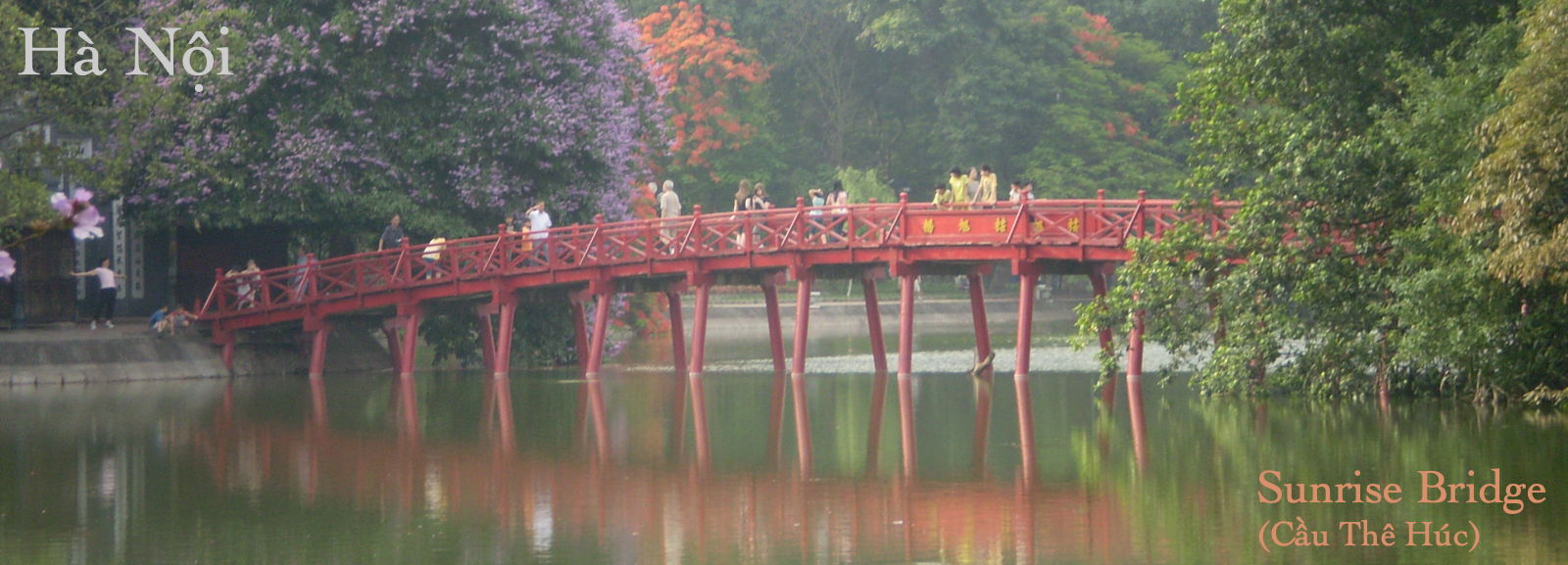Hà Nội
My first visit to Hanoi was by bicycle, as part of an REI tour in 1999 that started in Nanning, crossed the border into Vietnam at Móng Cái, and continued south to Hạ Long Bay. From the coast, we took the long flat road east to Hà Nội, a city trapped, as its name suggests, between two branches of the Sông Hồng (Red River).

Originally called the Paul Doumer Bridge, it was constructed in 1899-1902 when Doumer was Governor-General of Indochina. It carried his name until independence was won from the French in 1954
Below: Crossing the Long Biên bridge in 1999, when automobile traffic was handled by newer bridges.

Our entry into Hà Nội, over the fabled Long Biên Bridge, was an unforgettable finish to the long ride. When I lived in Saigon as a boy, a trip to Hanoi was almost unimaginable—North Vietnam was part of an alternate, forbidden universe. The bridge was a primary target of the bombing campaigns during the war, but somehow survived.
After 1975, as America tried to forget its Vietnam experience, the country seemed to have vanished altogether. It wasn’t until fairly late in the 1990s that it dawned on me that I could go back any time I wanted.
First Impressions
The most memorable parts of my first visit in 1999 were the stops at the Trấn Quốc pagoda and the "Temple of Literature." I found these sites both fascinating and quite mysterious, perhaps because our guide (a Catholic) was at a loss to explain what we were seeing. Ushering us in to the compound of the Trấn Quốc pagoda, he waved at the altars in the courtyard and exclaimed “Holy Mothers!”—and that was all we got in the way of explanations.
It was not until later that I really made a concerted effort to study the underlying historical strata of this ancient city, and learned that the cult of the Holy Mothers (Thánh Mẫu) is not a part of the Buddhist tradition, though some pagodas accommodate peripheral altars to them. In 2005, I embarked on a more ambitious program to study the oldest temples of Hanoi. My guide at the time was also a Catholic, but he was well versed in the iconography and architecture of the Buddhist pagodas, village temples, and Taoist worshipping halls.
We started out at the Láng Pagoda, in one of the outlying districts of Hanoi known for its silk production. It was here that I first experienced the natural hospitality of temple communities. When we wandered beyond the main sanctuary and back into courtyard with the nun's living quarters, we were discovered by the abbess and invited to tea.
As is typical in Vietnam, interest was expressed in my single status, especially given my advanced years. (The Vietnamese automatically add about 20 years for a beard.) A woman who sat down with us started chuckling and said that by now I should have "mười bồ" (10 girlfriends). As it turned out, she was not herself a nun, but part of the lay community that helps out around the temple. Given the condition of the abbess' teeth, it appeared to me that she was a devotee of the areca nut. Chewing areca nuts wrapped in betel leaves is supposed to develop strong teeth, though I have found little empirical evidence to support this idea. The areca nut is a mild narcotic, however, and that may help explain its popularity.
I think it was during my 2005 trip that I first visited the temple of Trấn Vũ (the Chinese name is Shenwu, “the Perfected Warrior”). The god is represented here in the form of a giant bronze statue that is the largest (and finest) work of its kind in Vietnam. The French mistakenly identified the statue as “the Grand Buddha,” but his identity is made clear by attributes: sword, snake, turtle, and bare feet.

Note the snake wrapped around the sword, and the turtle next to its point. Numerous images of Zhenwu paintings and statues can be found on the Web, including two magnificent bronzes: The Art Institute of Chicago, cat. no. 103 (1439); The British Museum, London (Museum no. 1908,0725.2, ca. 1416-1439).
Trấn Vũ is also known as the guardian of the “supreme emperor of the dark heavens” (Xuantian Shangdi 玄天上帝). Traditionally, xuan (dark) represents the northern direction and has the connotation of “mysterious” and “profound.” This derivation explains the placement of the temple to the north of the royal citadel. The statue was cast in the 1670s, at a time when the Qing court was finally securing its hold on southern China (Guangdong and Guangxi), so the Việt kingdom had a vital interest in symbolic protection in that quarter.
NOTE: The same deity appears in Chinese temples in the Mekong Delta as Bắc Đế (Northern Emperor).
It was perhaps during the literati literat revival of the “restored Lê” dynasty that Trấn Vũ was linked to three other “guardians” of Hanoi, one for each direction. If one were following the traditional arrangement of Taoist figures, one would expect to find a white tiger guarding the west, a blue dragon to the east, and a phoenix to the south.
However, the guardians of the cardinal directions in Hanoi are different, with three of them belonging to local tradition. The “White Horse” (Bạch Mã) temple, in the commercial quarter, guards the eastern approach to the citadel. Though relatively small, it is one of Hà Nội’s oldest and most interesting temples, connected by legend to the ancient Long Độ (“Dragon Navel”) spirit, the 9th century Chinese governor Gao Pian, and a spirit-horse who marked out the location of Thăng Long in 1010.
To the west, one finds the “Temple of the Kneeling Elephant” (Voi Phục), which honors a prince who died in the 1076 war with the Song. Finally, a temple to the mountain spirit Cao Sơn (at Kim Liên) protects the south.
I’ll have more to say about Hanoi, particularly the Temple of Literature (Văn Miếu), but will save it for another posting.
- Hanoi: Biography of a City , William Logan, University of Washington Press, 2001. A handy English-language introduction to the history of the city and its modern development. Logan has been a consultant to UNESCO and worked with the Hanoi Planning and Development Project.
- Hanoi: City of the Rising Dragon. Georges Boudarel, Rowman & Littlefield Publishers, Inc., June 2002. Unfortunately this excellent book is very hard to obtain in the U.S. It has some fascinating vignettes of the early days of Viet Minh rule under Ho Chi Minh (1945-47).
- Les Pagodes de Hanoi, Étude d’Archéologie et d’Épigraphie Annamites,G. Dumoutier, Imprimerie-Typographique F.H. Schneider, Hanoi, 1887.
- From the City Inside the Red River, Nguyên Đình Hòa, McFarland & Company, 1999. A personal memoir by a native of Hanoi and a noted scholar who taught in Saigon, Huế, California, and Canada. (Dr. Hòa also compiled a Vietnamese-English dictionary that is still being reprinted in Vietnam.)
- Trấn Quốc Pagoda, Friends of Vietnam Heritage, Thế Giới Publishers, 2003 - An excellent illustrated guidebook published by the Friends of Vietnam Heritage, explaining the arrangement of Buddhas, Bodhisattvas, and guardian figures, as well as the significance of the Holy Mothers.
- Quan Thánh Temple, Friends of Vietnamese Heritage, Nhà Xuất Bản Thế Giới, Hà Nội, 2002.
- Bạch Mã Temple, Friends of Vietnam Heritage, Thế Giới Publishers, 2001
- "Monumental Ambiguity: the State Commemoration of Ho Chi Minh," in Hue Tam Ho Tai in Essays into Vietnamese Pasts (Cornell University, 1995)
